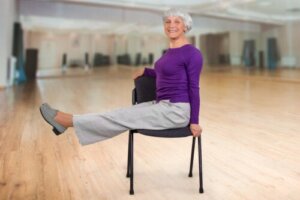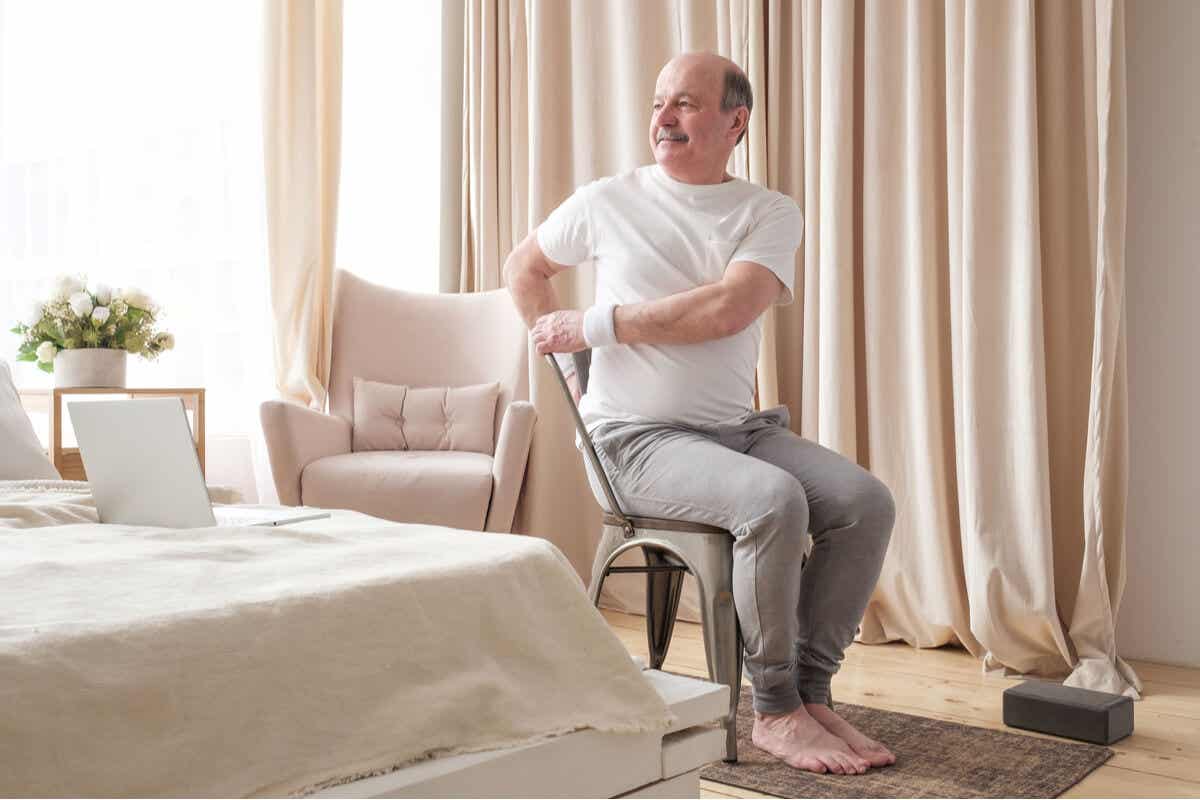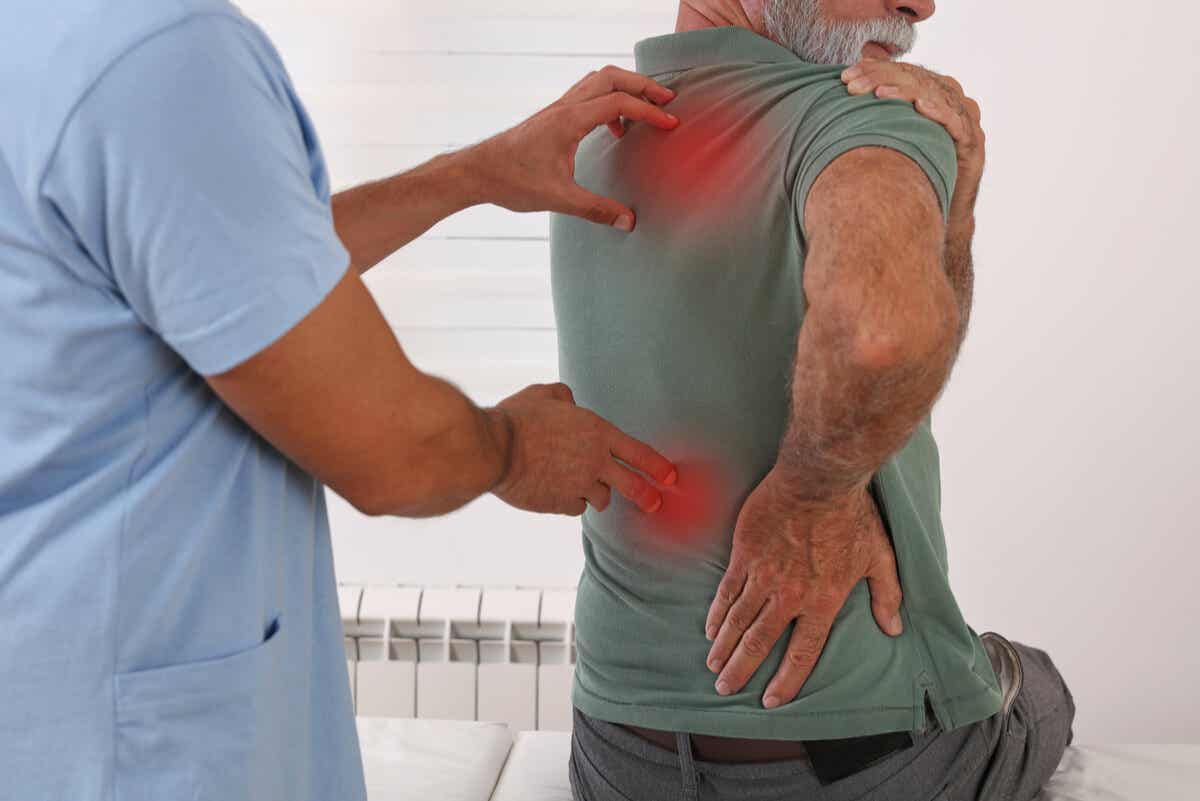Chair Yoga Exercises for Older Adults

Physical activity during old age is of great importance to ensure quality of life. From the age of 60 onwards, people should modify the type of discipline they practice, as high-impact activities such as running, cycling, or swimming aren’t very functional. It’s at this point that chair yoga for older adults may be the solution.
Chair yoga is a variant of traditional yoga in which the asanas or postures are reinterpreted to reduce their level of difficulty. All you need to do it is a stable chair, comfortable clothes, and a little space to stretch your arms and legs.
As we’ll see, it’s a discipline that doctors recommend for the elderly because it helps prevent or treat some common conditions during old age. Today we’ll teach you exercises that you can do without the help of an instructor, at home, and adapted to all levels.
7 chair yoga exercises for seniors
Although not all traditional yoga postures can be performed in this way, chair yoga for seniors integrates dozens of asanas that allow you to relax and stretch your arms, legs, and mid-trunk area.
Before pointing out 7 of the most commonly used exercises in group training, we invite you to consider the following:
- Use a chair without arms, which is comfortable and stable. Make sure it’s neither too high nor too low, so that it doesn’t limit the movements you can do on it.
- Place it on a flat surface. You must ensure that it has enough friction to prevent falls or loss of balance.
- Use flexible and sporty clothing. This will allow you to stretch more freely during the session.
- Choose a spacious area where you can bend your legs and arms without limitations.
The classes take place indoors, although if you have a garden, it’ll be perfect to add the component of relaxation and meditation. Before starting, it’s advisable to do stretches for each muscle group.
Also read: Practicing Yoga with Your Significant Other
1. Urdhva hastasana
Also known as arms up posture or palm tree pose. It’s useful for stretching the muscles of the arms and abdomen.
This is how you do it:
- Maintain a natural posture, with the back straight, shoulders relaxed, and chest and gaze forward.
- Place your arms on the sides of the chair. They should fall naturally and be fully stretched.
- The feet should be parallel to the front.
- Raise your arms without bending your elbow upward.
- Hold them there for a few seconds and then return them to their initial position.
- If you wish, you can alternate these movements with lifts from the flanks.
You should fix your gaze in front of you to avoid the accumulation of tension in the cervical vertebrae. Breathe slowly and deeply and don’t rush the movement so as not to compromise the back posture.

Discover: Everything You Need to Know About Prenatal Yoga
2. Eka pada rajakapotasana
Also known as pigeon pose, it’s been adapted in different ways for chair yoga for older adults. The one suitable for the beginner level is developed through these steps:
- Sit in a natural position and raise your left leg so that the ankle rests on the right leg.
- As much as possible, try to have the knee of the elevated leg aligned with the ankle; thus forming a straight line parallel to the floor.
- Extend your arms and hold this leg with the natural opening of your shoulders.
- Make rocking movements back and forth with your torso, taking care of your back at all times. Your back should be straight and free of tension.
Remember to keep the supporting foot firm to achieve the necessary balance. After a couple of seconds, alternate your legs and repeat the steps.
3. Garudasana
Also called the eagle pose, it’s perfect for stretching joints and muscles in the arms and legs. Although the tension is less, it also involves the abdomen in order to maintain balance and an upright position.
Do it with the help of these instructions:
- Sit in a natural position and cross your left leg over your right. Your foot should wrap over your calf, so that they’re intertwined.
- Cross your left arm with your right arm at the elbow. Your palms should also interlock to create tension.
- Keep your back straight, eyes forward, shoulders relaxed, and lean forward a little if you need to for better balance.
- After a couple of seconds with slow breathing, repeat the steps, but this time alternating legs and arms.
- If any condition such as osteoporosis or arthritis limits the interlocking, you should only do it as far as you feel comfortable.
4. Ardha matsyendrasana
Also called half twisting posture, it’s indicated for those who suffer from lumbar or back pain. Its original version is performed sitting on the floor, but it’s adapted to chair yoga for seniors as follows:
- Sit sideways in the chair, with your whole body pointing to the right.
- Stretch your back straight, bring your feet together and create some tension in your abdomen.
- Slowly rotate your upper torso until you’re facing the back of the chair.
- As much as possible, try not to take your legs off the floor and keep your hips static.
- You can hold the backrest with your hands to complete the movement. Hold the tension for a few seconds and then return to the starting position.
- After 5-10 repetitions, switch sides and apply the steps to the other side of your body.
5. Virabhadrasana
Also called warrior’s pose, it has two variants classified as I and II. It requires greater endurance and strength than the previous ones, although with a little practice any older adult can perform it.
Let’s see the step by step instructions:
- On your side, place your right leg so that the lower thigh, the biceps femoris, rests on the seat. The calf should form a vertical line and the foot should be in full contact with the floor.
- The other leg, the left leg, should be stretched backwards so that it forms a straight line. In this case, only the toes of your foot should touch the floor.
- With your back straight and your torso firm, stretch your arms up and press your palms together.
- Hold this position for several seconds and then alternate sides.
- The second variation is identical, only this time you bend your arms all the way down to form a horizontal line with the floor. You can include it if you want more mobility in your upper trunk.
6. Utthita parsvakonasana
Known in the traditional variant as extended side angle, this position is perfect for stretching all the muscles of the back. It demands a greater degree of flexibility and has the following steps:
- Sit in a natural position with your arms straight out to the sides.
- Tilt your body to the left, bring it forward and touch the palm of your right hand to the floor. The arm should be fully extended and the base of contact should be one or two centimeters above your left foot.
- Extend your left arm fully upward and fix your gaze on it.
- You must watch your back while performing the movement. Make sure it’s straight and doesn’t accumulate more tension than necessary.
- After holding the pose for several seconds, switch sides to activate the muscles on the other side.
Specialists only suggest this chair yoga asana for seniors if they’ve already mastered the previous ones. Otherwise, you may incur injury or discomfort in the lower back.
7. Uttanasana
To finish with a complete session, the pincer pose or uttanasana can’t be missed. As in the previous case, specialists only recommend it for older people who already have sufficient strength and flexibility:
- Sit in the starting position with your arms outstretched at your sides.
- Slowly move them downwards towards the front. In the process, take care of your back and direct your gaze to its natural position as you lower them.
- Move the palms of your hands towards the floor and hold this position for several seconds.
- Your shoulders should be forward, your arms fully extended and your heels shouldn’t leave the floor.
If the last step isn’t possible, you can leave only your fingers as a contact surface, but keep in mind that this increases the tension in your back.

Benefits of yoga for the health of seniors
After a couple of weeks of implementing a chair yoga routine for older adults, you’ll begin to perceive its main benefits. Although there are dozens of them, the relevant ones are the following:
- Improves balance and prevents falls: Studies suggest that a 12-week yoga program for seniors over 65 can reduce the risk of falls by 6% and increase balance and flexibility by 4% and 34%.
- Helps with psychological well-being: Evidence suggests that yoga can significantly reduce episodes of anger, anxiety, and depression, as well as increasing self-efficacy, self-esteem, and overall psychological well-being.
- Improves sleep quality: In the medium and long term, it’s also been shown to have a positive impact on the reconciliation of sleep. Older adults obtain this benefit, on average, after three months of chair yoga.
- Contributes to flexibility and cognition: We know that yoga is of great help in improving flexibility, a feature that contributes to quality of life in old age. Research points to its effectiveness in improving cognition. It’s even used frequently in adults with Alzheimer’s disease.
- Increases walking speed and mobility in general: This is certified by the evidence, that shows yoga can be an activity that helps you to carry out other activities in the medium and long term.
- It works as an adjuvant for arthritis: Studies show that a continuous yoga program for adults can reduce the stiffness and pain caused by arthritis.
The above-mentioned benefits only manifest themselves when people perform the yoga sessions regularly during the week. These can be combined with other types of activities performed by older adults. The important thing, in any case, is to avoid a sedentary lifestyle.
All cited sources were thoroughly reviewed by our team to ensure their quality, reliability, currency, and validity. The bibliography of this article was considered reliable and of academic or scientific accuracy.
- Chen, K. M., Chen, M. H., Chao, H. C., Hung, H. M., Lin, H. S., & Li, C. H. Sleep quality, depression state, and health status of older adults after silver yoga exercises: cluster randomized trial. International journal of nursing studies. 2009; 46(2): 154-163.
- Furtado, G. E., Uba-Chupel, M., Carvalho, H. M., Souza, N. R., Ferreira, J. P., & Teixeira, A. M. Effects of a chair-yoga exercises on stress hormone levels, daily life activities, falls and physical fitness in institutionalized older adults. Complementary therapies in clinical practice. 2016; 24: 123-129.
- Hansen, E. D.Yoga for seniors with arthritis: A pilot study. International Journal of Yoga Therapy. 2011; 20(1): 55-60.
- Nick, N., Petramfar, P., Ghodsbin, F., Keshavarzi, S., & Jahanbin, I. The effect of yoga on balance and fear of falling in older adults. PM&R. 2016: 8(2), 145-151.
- Patel, N. K., Newstead, A. H., & Ferrer, R. L. The effects of yoga on physical functioning and health related quality of life in older adults: a systematic review and meta-analysis. The journal of alternative and complementary medicine. 2012; 18(10): 902-917.
- Roland, K. P., Jakobi, J. M., & Jones, G. R. Does yoga engender fitness in older adults? A critical review. Journal of aging and physical activity. 2011; 19(1): 62-79.
- Schmid, A. A., Van Puymbroeck, M., & Koceja, D. M. Effect of a 12-week yoga intervention on fear of falling and balance in older adults: a pilot study. Archives of physical medicine and rehabilitation. 2010; 91(4): 576-583.
This text is provided for informational purposes only and does not replace consultation with a professional. If in doubt, consult your specialist.








